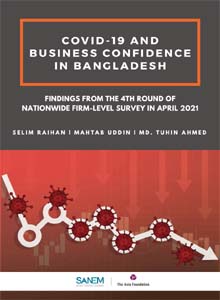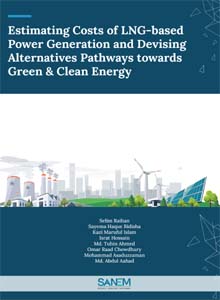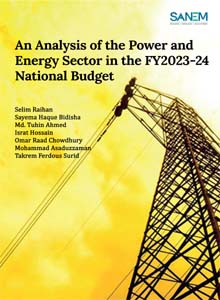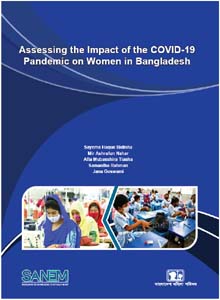
COVID-19 and Business Confidence in Bangladesh: Findings from the 4th Round of Nationwide Firm-level Survey in April 2021
 Citation: Raihan, S., Uddin, M., & Ahmed, M.T. (2021). COVID-19 and business confidence in Bangladesh: Findings from the 4th round of nationwide firm-level survey in April 2021. SANEM Publications, Dhaka, Bangladesh.
Citation: Raihan, S., Uddin, M., & Ahmed, M.T. (2021). COVID-19 and business confidence in Bangladesh: Findings from the 4th round of nationwide firm-level survey in April 2021. SANEM Publications, Dhaka, Bangladesh.
.Abstract: COVID-19 pandemic has had a significant, negative impact on the global economy – rising levels of poverty, unemployment, business costs and closures due to lockdowns and restricted business activity are just some of the economic effects that have led to the largest global recession in history, which is still ongoing. The shock of the pandemic is being felt in the Bangladeshi economy as well, with similar effects. This is a cause of concern for the Government of Bangladesh (GoB); it is aiming to support the economy towards recovery by providing multiple incentive packages for businesses. While some progress has been made, the speed of recovery is still quite slow; although the distribution of vaccines provides some hope. The private sector is one of the biggest driving forces of the economy, which is why it should also be closely monitored.
In this respect, this study convened a survey of 503 firms across the country (253 manufacturing; 250- services sector firms). Seven sub-sectors in the manufacturing industry and eight sub-sectors in the services industry were identified based on Bangladesh’s latest available National Accounts Statistics. The survey covers RMG, Textiles, Pharmaceuticals, Leather and Tannery, Light Engineering, Food Processing, etc. in the manufacturing sector. In the Services sector, this study covers Wholesales, Retailers, Restaurants, Transport, ICT and Telecommunication, Financial Sectors, Real Estate, etc. The number of firms to be surveyed for each of the sub-sectors was chosen based on the sub-sectors contribution to the GDP.
Based on the survey responses, this study constructs four indices, namely – (i) Present Business Status Index in January-March 2021 compared to October-December 2020, (ii) Present Business Status Index in January-March 2021 compared to January-March 2020, (iii) Business Confidence Index for April-June 2021 compared to January-March 2021 and (iv) Enabling Business-Environment Index (EBI). The indices are first prepared at the firm level and later aggregated to the sub-sectoral and sectoral level incorporating appropriate weights.
There have been some improvements in overall business status in January-March 2021 compared to the business status in October-December 2020 – while the increase is not as significant as that seen between July-September 2020 and April-June 2020, it is a greater change compared to the one seen in the previous round of the survey. The PBSI (quarter) score has finally gone above 50, which means that firms are in a better position in January-March 2021 compared to the previous quarter. This is the same case when comparing the business status to that of the same quarter in 2020 – although the score remains below 50. This implies that, despite improvements, firms have not recovered to their pre-pandemic status. Sectors are experiencing recovery at varying paces. Faster recovery is taking place in the Pharmaceuticals and Chemicals, and Financial sectors.
Profitability, investment, and sales/export indicators have shown consistent improvement in PBSI throughout the four rounds of the survey. The business cost indicator, which had gone down in the previous round, has had significant improvement. On the other hand, employment and wage indicators have seen slight decreases.
The business confidence for April-June 2021 shows a significant decline over business confidence in January-March 2020. This is quite concerning, as there had been consistent increases in the BCI in all the previous rounds. Even in the sub-indicators, all of them have seen a decrease in their BCI scores for the April-June 2021 quarter compared to the previous quarter. A possible explanation for this fall in business confidence is the second wave of COVID-19 taking place in 2021, along with fears of new variants of the disease spreading in the country.
The EBI scores in all four rounds are found between 25 and 50, indicating that the overall business environment is unfavourable for the firms. However, there is some hope in the fourth round – while the EBI score previously decreased in the third round, it has increased in the January-March 2021 quarter. Similar trends are seen in the sub-indicators, where most of them have had increases in their EBI scores.
There has been a sequential decline in the gap between expectations and reality amongst the firms. In this round, BCI scores were lower than the PBSI scores for the first time. Thus, the ratio between BCI and PBSI fell below 1 for most of the firms.
Before the current upsurge of COVID-19 (in March 2021), 34% of the firms thought that the economy was on a strong recovery, while 14% of the firms stated it was on a weak recovery, and 52% thought it was on a moderate recovery.
After the current upsurge of the COVID-19, only 2% of the firms stated that the economy would be on a strong recovery, 68% thought it would be on a weak recovery, and 31% thought it would be on a moderate recovery.
The firms, on average, have been able to recover themselves by 57% of the damages that occurred during the pandemic (March 2020 – March 2021). Most notably, the Financial sector has been able to recover 73% of their damages, followed by Pharmaceuticals and Chemicals (72%), RMG (67%), and Textiles (66%), amongst others. This shows that the firms have not gone back to the pre-pandemic situation as of yet.
In the fourth round, around 69% of the surveyed firms have not received a stimulus package. Among the overall stimulus package recipients, 57.8% of RMG firms received the package while no ICT & Telecommunication and Other Services firms received it. In terms of firm size, only 9% of micro and small firms have received the package, while 46% of large firms were recipients.
Like the previous rounds of the survey, recipients of the packages faced problems due to lengthy procedures, difficulty in bank services, and procedural application systems. Those who did not receive it said that the incentive package is not a grant, no package for the industry, procedural and bank-related difficulties. No significant improvements were observed on these indicators.



